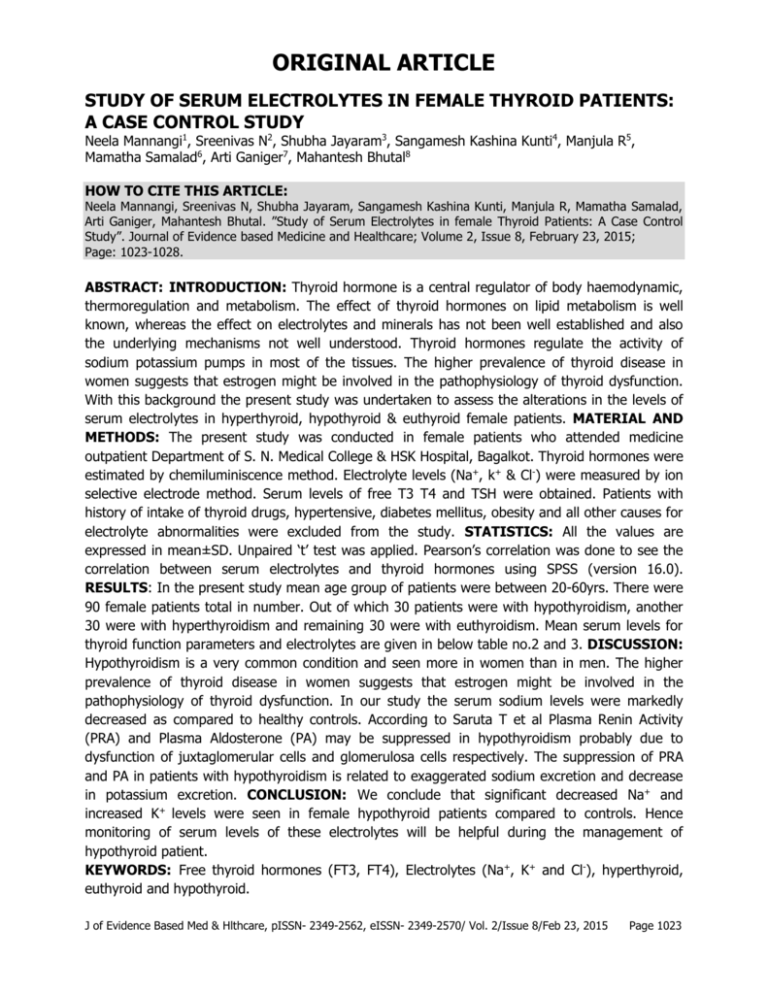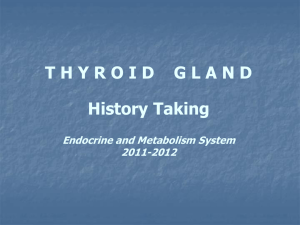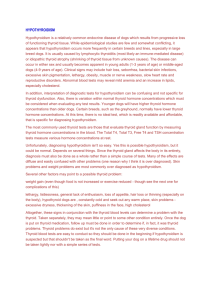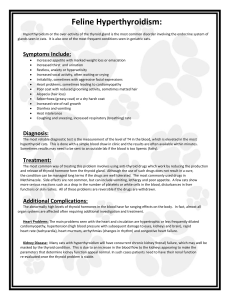study of serum electrolytes in female thyroid patients: a case control
advertisement

ORIGINAL ARTICLE STUDY OF SERUM ELECTROLYTES IN FEMALE THYROID PATIENTS: A CASE CONTROL STUDY Neela Mannangi1, Sreenivas N2, Shubha Jayaram3, Sangamesh Kashina Kunti4, Manjula R5, Mamatha Samalad6, Arti Ganiger7, Mahantesh Bhutal8 HOW TO CITE THIS ARTICLE: Neela Mannangi, Sreenivas N, Shubha Jayaram, Sangamesh Kashina Kunti, Manjula R, Mamatha Samalad, Arti Ganiger, Mahantesh Bhutal. ”Study of Serum Electrolytes in female Thyroid Patients: A Case Control Study”. Journal of Evidence based Medicine and Healthcare; Volume 2, Issue 8, February 23, 2015; Page: 1023-1028. ABSTRACT: INTRODUCTION: Thyroid hormone is a central regulator of body haemodynamic, thermoregulation and metabolism. The effect of thyroid hormones on lipid metabolism is well known, whereas the effect on electrolytes and minerals has not been well established and also the underlying mechanisms not well understood. Thyroid hormones regulate the activity of sodium potassium pumps in most of the tissues. The higher prevalence of thyroid disease in women suggests that estrogen might be involved in the pathophysiology of thyroid dysfunction. With this background the present study was undertaken to assess the alterations in the levels of serum electrolytes in hyperthyroid, hypothyroid & euthyroid female patients. MATERIAL AND METHODS: The present study was conducted in female patients who attended medicine outpatient Department of S. N. Medical College & HSK Hospital, Bagalkot. Thyroid hormones were estimated by chemiluminiscence method. Electrolyte levels (Na+, k+ & Cl-) were measured by ion selective electrode method. Serum levels of free T3 T4 and TSH were obtained. Patients with history of intake of thyroid drugs, hypertensive, diabetes mellitus, obesity and all other causes for electrolyte abnormalities were excluded from the study. STATISTICS: All the values are expressed in mean±SD. Unpaired ‘t’ test was applied. Pearson’s correlation was done to see the correlation between serum electrolytes and thyroid hormones using SPSS (version 16.0). RESULTS: In the present study mean age group of patients were between 20-60yrs. There were 90 female patients total in number. Out of which 30 patients were with hypothyroidism, another 30 were with hyperthyroidism and remaining 30 were with euthyroidism. Mean serum levels for thyroid function parameters and electrolytes are given in below table no.2 and 3. DISCUSSION: Hypothyroidism is a very common condition and seen more in women than in men. The higher prevalence of thyroid disease in women suggests that estrogen might be involved in the pathophysiology of thyroid dysfunction. In our study the serum sodium levels were markedly decreased as compared to healthy controls. According to Saruta T et al Plasma Renin Activity (PRA) and Plasma Aldosterone (PA) may be suppressed in hypothyroidism probably due to dysfunction of juxtaglomerular cells and glomerulosa cells respectively. The suppression of PRA and PA in patients with hypothyroidism is related to exaggerated sodium excretion and decrease in potassium excretion. CONCLUSION: We conclude that significant decreased Na+ and increased K+ levels were seen in female hypothyroid patients compared to controls. Hence monitoring of serum levels of these electrolytes will be helpful during the management of hypothyroid patient. KEYWORDS: Free thyroid hormones (FT3, FT4), Electrolytes (Na+, K+ and Cl-), hyperthyroid, euthyroid and hypothyroid. J of Evidence Based Med & Hlthcare, pISSN- 2349-2562, eISSN- 2349-2570/ Vol. 2/Issue 8/Feb 23, 2015 Page 1023 ORIGINAL ARTICLE INTRODUCTION: Thyroid hormone is a central regulator of body haemodynamic, thermoregulation and metabolism. Thyroid hormones perform a wide array of metabolic functions including regulation of lipid, carbohydrate, protein and electrolyte and mineral metabolisms. While the effect of thyroid hormones on lipid metabolism is well known, the effect on electrolytes and minerals has not been well established and also the underlying mechanisms not well understood.[1] Therefore the present study was undertaken to assess the levels of serum electrolytes in patients with thyroid disorders. Sodium and potassium are important components of the enzyme Na+-K+ ATPase, which is an enzyme present on the cell membrane that helps in the transport of water and nutrients across the cell membrane.[2] Thyroid hormones regulate the activity of sodium potassium pumps in most of the tissues.[3] With this background the present study was undertaken to assess the alterations in the levels of serum electrolytes in hyperthyroid, hypothyroid & euthyroid patients. The higher prevalence of thyroid disease in women suggests that estrogen might be involved in the pathophysiology of thyroid dysfunction. Estradiol has an antagonistic effect on the hormones T3 and T4. The reason being, estradiol competes with T3 and T4 for binding sites on the receptor proteins.[4] Hence the present study was done only in female thyroid patients and controls. MATERIAL & METHODS: The present study was conducted in female patients who attended medicine outpatient department of S. N. Medical College & HSK Hospital, Bagalkot. The study was conducted from January 2013 – Dec 2013.The patients were categorised into three groups based on thyroid hormone levels into euthyroid (controls), hyperthyroid & hypothyroid respectively. Patients with history of intake of thyroid drugs, hypertensive, diabetes mellitus, obesity were excluded from the study. Thyroid hormones were estimated by chemiluminiscence method using Maglume Snibe 1000 instrument. Electrolyte levels (Na+, k+ & Cl-) were measured by ion selective electrode method using[5] Eschweiler combi in all the groups. 5ml venous blood was collected using plain test tube and subjected to centrifugation. Serum levels of free T3, T4 and TSH were obtained. Normal ranges for TSH, fT4 and fT3 were 0.35–4.5 mU/l, 9.5–25 pmol/l and 2.9–6.5 pmol/l, respectively. Hypothyroidism was defined as fT4 concentration below the normal range value, hyperthyroidism as fT4 and/or fT3 concentration above the normal range. STATISTICS: All the values are expressed in mean±SD. Unpaired ‘t’ test was applied. Pearson’s correlation was done to see the correlation between serum electrolytes and thyroid hormones using SPSS (version 16.0). RESULTS: In the present study mean age group of patients were between 20-60yrs. There were 90 female patients total in number. Out of which 30 patients were with hypothyroidism, another 30 were with hyperthyroidism and remaining 30 were with euthyroidism. Mean serum levels for thyroid function parameters and electrolytes are given in below table no. 2 and 3. Electrolyte changes were seen only in hypothyroidism. Among which Na+ was decreased and serum Cl- was increased & both were statistically significant. Whereas, Serum K+ was also increased but statistically not significant. No significant changes were seen in hyperthyroidism. J of Evidence Based Med & Hlthcare, pISSN- 2349-2562, eISSN- 2349-2570/ Vol. 2/Issue 8/Feb 23, 2015 Page 1024 ORIGINAL ARTICLE DISCUSSION: Hypothyroidism is a condition in which the body suffers from insufficient thyroid hormone. Since thyroid hormones are involved in controlling various metabolisms, more importantly lipid metabolism and that of various electrolytes.[2] The hypothyroid patient generally suffers from a slow metabolism resulting in dyslipidemias and electrolyte disturbances. Hypothyroidism is a very common condition and seen more in women than in men. Earlier statistics also have suggested that hypothyroidism is six times more common in women than in men. The higher prevalence of thyroid disease in women suggests that estrogen might be involved in the pathophysiology of thyroid dysfunction. Estradiol has an antagonistic effect on the hormones T3 and T4. The reason being, estradiol competes with T3 and T4 for binding sites on the receptor proteins.[4] Estradiol also limits the thermogenic action of T4 and promotes storage of fat. Hypothyroidism is one of the most prevalent endocrine diseases. It can lead to a variety of clinical situations, including congestive heart failure, electrolyte disturbances and coma. Hyponatremia is the most common electrolyte abnormality encountered in clinical practice[6]. In our study the serum sodium levels in cases was markedly decreased as compared to healthy controls. According to Saruta T et al Plasma Renin Activity (PRA) and Plasma Aldosterone (PA) may be suppressed in hypothyroidism probably due to dysfunction of juxtaglomerular cells and glomerulosa cells respectively and the possibility that suppression of PRA and PA in patients with hypothyroidism is related to exaggerated sodium excretion and decrease in potassium excretion.[5] Study done by Christoph Schwarz et al observed association between thyroid hormones and electrolyte disorders. In his study there was decreased sodium and increased potassium levels in hypothyroidism. According to him electrolyte abnormalities are relevant only in marked hyper and hypothyroidism.[7] Our study is in conformity with the study done by Christoph where we too observed electrolyte changes in hypothyroidism. Study done by Murgod et al observed electrolyte changes and lipid abnormalities in hypothyroidism. In their study they found decreased sodium and decreased potassium levels along with lipid abnormality in hypothyroidism. However our study was not in conformity with the study done by Murgod et al,. In the present study along with decreased sodium there was increased potassium. According to them, Thyroid hormones regulate the activity of sodium potassium pumps in most of the tissues by regulating Na –K ATP as and in hypothyroidism because of low potassium levels, and because of deficiency of thyroid hormones, this enzyme is affected, resulting in accumulation of water inside the cells and causing edema. This is said to be one of the mechanisms responsible for weight gain seen in hypothyroid patients.[3] Hyponatraemia was recently shown to be associated with an increased risk of falls and fractures, making the subject more relevant for patients prognosis, especially the elderly.[8] Sodium and chloride are interdependent and changes in sodium ions will also be reflected in the chloride ions. it is postulated that hormones which are involved in ECFV (Extracellular Fluid Volume) regulation act on renal sodium transporters may also modulate the renal chloride transporters.[9] Besides the classic hormones, such as aldosterone, that are known to be involved in the regulation of NaCl transport by the kidney other hormones, such as thyroid hormone, are also capable of regulating the ECFV via modulation of nephron ion and fluid transport.[10] Importantly, thyroid hormone modulates the expression of Na+/K+ ATPase mRNA and protein, J of Evidence Based Med & Hlthcare, pISSN- 2349-2562, eISSN- 2349-2570/ Vol. 2/Issue 8/Feb 23, 2015 Page 1025 ORIGINAL ARTICLE and hence regulates the activity of this critical component of renal sodium transport.[11] In proximal tubule, thyroid hormone acts on the Na+/H+ exchanger to change intratubular acidification dynamics. Thus, the thyroid hormones act by regulating the expression of different sodium and chloride transporters in the kidney is plausible in the light of its involvement in increasing renal fluid reabsorption.[12] Therefore there is increased chloride level in hypothyroidism patients. CONCLUSION: We conclude that significant decreased Na+ and increased K+ levels were seen in female hypothyroid patients compared to controls. Hence monitoring of serum levels of these electrolytes will be helpful during the management of hypothyroid patients. LIMITATION: Simultaneously along with female patients we should have compared with male patients to make it more effective study. Groups Hypothyroidism Hyperthyroidism Euthyroidism Mean ± S.D 33.87±9.6yrs 38.36±12.4yrs 40.90±10.0yrs Table 1: Showing mean age distribution of patients and controls Serum(meq/lt) Na K Cl Hypothyroidism 142.93 ± 1.71 4.53 ± 0.72 106.83 ± 1.38 Euthyroid 146.32 ± 1.71 3.89 ± 1.63 100.00 ± 1.72 P 0.007** 0.051 0.00** Table 2: Comparing electrolytes between hypothyroidism and euthyroidism P<0.05, ** very significant. Serum(meq/lt) Na K Cl Hyperthyroidism 147.19 ± 1.10 4.10 ± 0.62 99.87 ± 1.12 Euthyroid 146.32 ± 1.52 3.89 ± 1.63 100.00 ± 1.22 P 0.57 0.499 0.90 Table 3: Comparing electrolytes between hyperthyroidism and euthyroidism J of Evidence Based Med & Hlthcare, pISSN- 2349-2562, eISSN- 2349-2570/ Vol. 2/Issue 8/Feb 23, 2015 Page 1026 ORIGINAL ARTICLE REFERENCES: 1. Mariani LH, Berns JS. The renal manifestations of thyroid disease. J Am Soc Nephrol. 2012; 23(1): 22–26. 2. Murgod R, Soans G. Changes in Electrolyte and Lipid profile in Hypothyroidism. International Journal of Life science and Pharma research. 2012; 2(3): 185-194. 3. Ismail Beigi F, Edelman IS. The mechanism of the calorigenic effect of thyroid hormone stimulation of Na+ + K+ activated adenosinetri phosphatase activity. J gen Physiol.1971; 57: 710. 4. Vasudevan N, Ogawa S, Praff D. Estrogen and thyroid hormone interactions: Physiological stability by molecular specificity. Physiol Rev.2002; 82: 923-944. 5. Saruta T, Kitajima W, Hayashi M, Kato E, Matsuki S. Renin and aldosterone in hypothyroidism: Relation to excretion of sodium and potassium. ClinEndocrinol. 1980; 12: 483-489. 6. Kargili A, Turgut FH, Karakurt F, Kasapoglu B, Kanbay M, Akcay A. A forgotten but important risk factor for severe hyponatremia: myxedema coma. Clinics (Sao-Paulo). 2010; 65: 447-448. 7. Schwarz C, Leichtle AB, Arampatizis S, Fiedler GM, Zimmermann H, Exadaktlyos AK, Lindner G. Thyroid function and serum electrolytes: does an association really exist?. The European Journal of Medical Science. 2012; 142: w13669. 8. Renneboog B, Musch W, Vandemergel X, Manto MU, Decaux G. Mild chronic hyponatremia is associated with falls, unsteadiness, and attention deficits. Am J Med. 2006; 119(1): 711– 718 9. Santos Ornellas D, Grozovsky R, Goldenberg RC, Carvalho DP, Fongi P, Gugginoi WP, Morales M. Thyroid hormone modulates ClC-2 chloride channel gene expression in rat renal proximal tubules. Journal of Endocrinology 2003; 178: 503–511. 10. Masilamani S, Kim GH, Mitchell C, Wade JB & Knepper MA. Aldosterone-mediated regulation of EnaC alpha, beta, and gamma subunit proteins in rat kidney. Journal of Clinical Investigation 1999; 104: 19–23. 11. McDonough AA, Brown TA, Horowitz B, Chiu R, Schlotterbeck, Bowen J & Schmitt. Thyroid hormone coordinately regulates Na+-K+ATPase _- and _-subunit mRNA levels in kidney. American Journal of Physiology. Cell Physiology 1988; 254: 323–329. 12. Edelman IS. Thyroidal regulation of renal energy metabolism and (Na-K)-activated adenosine triphosphatase activity. Medical Clinics of North America 1975; 59: 605–614.0 J of Evidence Based Med & Hlthcare, pISSN- 2349-2562, eISSN- 2349-2570/ Vol. 2/Issue 8/Feb 23, 2015 Page 1027 ORIGINAL ARTICLE AUTHORS: 1. Neela Mannangi 2. Sreenivas N. 3. Shubha Jayaram 4. Sangamesh Kashina Kunti 5. Manjula R. 6. Mamatha Samalad 7. Arti Ganiger 8. Mahantesh Bhutal PARTICULARS OF CONTRIBUTORS: 1. Assistant Professor, Department of Biochemistry, S. N. Medical College & HSK Hospital, Bagalkot. 2. Associate Professor, Department of Pathology, MMC & RI, Mysore. 3. Associate Professor, Department of Biochemistry, MMC & RI, Mysore. 4. Associate Professor, Department of Biochemistry, S. N. Medical College & HSK Hospital, Bagalkot. 5. Assistant Professor, Department of Community Medicine, S. N. Medical College & HSK Hospital, Bagalkot. 6. Post Graduate Student, Department of Biochemistry, S. N. Medical College & HSK Hospital, Bagalkot. 7. Post Graduate Student, Department of Biochemistry, S. N. Medical College & HSK Hospital, Bagalkot. 8. Post Graduate, Department of Biochemistry, S. N. Medical College & HSK Hospital, Bagalkot. NAME ADDRESS EMAIL ID OF THE CORRESPONDING AUTHOR: Dr. Sreenivas N, Associate Professor, Department of Pathology, Mysore Medical College & Research Institute, Mysore. E-mail: sreenivassimha@rediffmail.com Date Date Date Date of of of of Submission: 09/02/2015. Peer Review: 10/02/2015. Acceptance: 15/02/2015. Publishing: 19/02/2015. J of Evidence Based Med & Hlthcare, pISSN- 2349-2562, eISSN- 2349-2570/ Vol. 2/Issue 8/Feb 23, 2015 Page 1028








